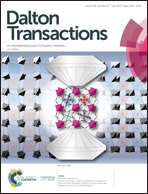A molecular electron density theory study of the insertion of CO into frustrated Lewis pair boron-amidines: a [4 + 1] cycloaddition reaction†
Abstract
The insertion of CO into hydrogenated boron-amidine 1 yielding five-membered diazaborolone (5DAB) 3 has been studied within the molecular electron density theory (MEDT) at the DFT ωB97X-D/6-311G(d,p) level. This is a domino process comprised of two consecutive reactions: (i) the dehydrogenation of 1 yielding the frustrated Lewis pair (FLP) boron-amidine 4, which quickly equilibrates with four-membered diazaborolone (4DAB) 2; and (ii) the addition of CO into FLP 4, yielding the final 5DAB 3. Analysis of the Gibbs free energies indicates that the extrusion of H2 demands a high ΔG≠ of 28.6 kcal·mol−1, being endergonic by 6.7 kcal·mol−1. The subsequent addition of CO into FLP 4 presents a low ΔG≠ of 15.0 kcal·mol−1; formation of 5DAB 3 being exergonic by −5.7 kcal·mol−1 from hydrogenated boron-amidine 1. An analysis of the bonding changes along the insertion of CO in a smaller FLP model indicates that this reaction can be considered a [4 + 1] cycloaddition reaction taking place via a five-membered pseudocyclic transition state associated with a two-stage one-step mechanism. Analysis of the conceptual DFT reactivity indices suggests that the initial attack of CO on FLP 4 is an acid/base process in which the carbenoid carbonyl character allows CO to participate as a Lewis base, rather than a nucleophilic/electrophilic interaction. The results arising from the analysis of the Parr functions, however, coincide with this behaviour.
![Graphical abstract: A molecular electron density theory study of the insertion of CO into frustrated Lewis pair boron-amidines: a [4 + 1] cycloaddition reaction](/en/Image/Get?imageInfo.ImageType=GA&imageInfo.ImageIdentifier.ManuscriptID=C9DT01489F&imageInfo.ImageIdentifier.Year=2019)


 Please wait while we load your content...
Please wait while we load your content...